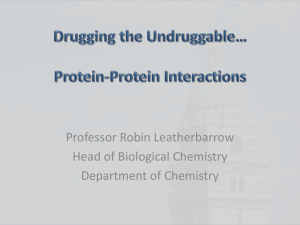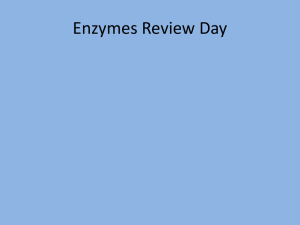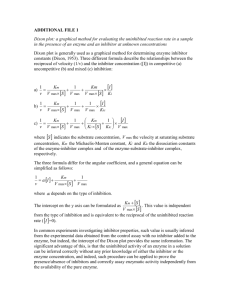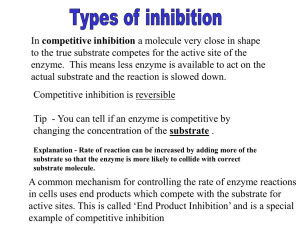Exam 2
advertisement
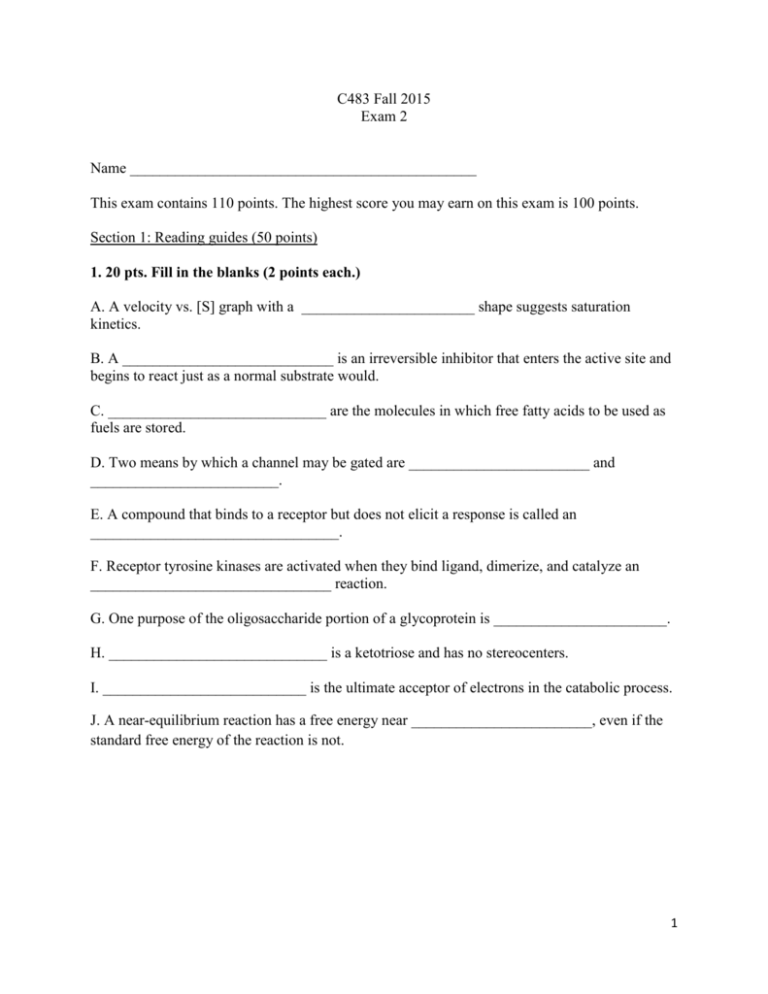
C483 Fall 2015 Exam 2 Name ______________________________________________ This exam contains 110 points. The highest score you may earn on this exam is 100 points. Section 1: Reading guides (50 points) 1. 20 pts. Fill in the blanks (2 points each.) A. A velocity vs. [S] graph with a _______________________ shape suggests saturation kinetics. B. A ____________________________ is an irreversible inhibitor that enters the active site and begins to react just as a normal substrate would. C. _____________________________ are the molecules in which free fatty acids to be used as fuels are stored. D. Two means by which a channel may be gated are ________________________ and _________________________. E. A compound that binds to a receptor but does not elicit a response is called an _________________________________. F. Receptor tyrosine kinases are activated when they bind ligand, dimerize, and catalyze an ________________________________ reaction. G. One purpose of the oligosaccharide portion of a glycoprotein is _______________________. H. _____________________________ is a ketotriose and has no stereocenters. I. ___________________________ is the ultimate acceptor of electrons in the catabolic process. J. A near-equilibrium reaction has a free energy near ________________________, even if the standard free energy of the reaction is not. 1 2. 10 pts. True or false (1 points each) A. ____________ The derivation of the Michaelis-Menton equation assumes that the concentration of enzyme is much lower than the concentration of substrate in a reaction. B. ____________ Tylenol is toxic at high doses because it is a reversible inhibitor of COX enzyme. C. ____________ Cholesterol maintains bilayer fluidity over a broad range of temperatures because it is able to increase membrane fluidity at low temperatures and decrease fluidity at high temperatures. D. ____________ Because a membrane potential of -70 mV makes the inside of a nerve cell slightly negative, positively charged sodium and potassium ions enter the cell spontaneously. E. ____________ The potassium ion channel is unable to selectively exclude sodium ion because both ions are positively charged. F. ____________ 7-Transmembrane helices are structurally suited to being receptors because they span the cell membrane and have the ability to bind molecules selectively on both the inside and outside of the cell. G. ____________ Unlike protein hormones, lipid hormones do not need membrane-bound receptors because lipid hormones can travel through the membrane to bind their targets. H. ____________ Structurally, starch and cellulose differ in their carbohydrate composition but not their glycosidic bonds. I. _____________ NAD+ is the oxidized form of the cofactor. J. _____________ Unlike carbohydrates and fats, which are stored as glycogen and triacylglycerides, amino acids have no dedicated metabolic storage molecule. 3. 20 pts. Short answer (5 points each) A. Draw a naturally occurring omega-3 fatty acid with 16 carbon atoms. 2 B. Draw a Michaelis-Menton graph TO SCALE (fill in numbers on the x and y axes) for an enzyme with kcat = 500 s- and Km = 100 M. The experiment was conducted with total enzyme concentration of 1 nM. C. Tagatose is an artificial sweetener that is the C-4 epimer of fructose. Draw its structure in open chain form. D. Which of the compounds from Table 12.4 (last page) could be involved in a reaction coupled to the spontaneous synthesis of ATP from ADP and Pi? Choose one of these compounds and calculate the standard free energy of that coupled reaction. 3 Section 2: Problems (10 points each) 4. For each of the following reactions, tell whether it is an oxidation, reduction, or neither. Then tell the net change in high energy bonds. Reaction Oxidation, reduction, neither? Net change in high energy bonds A. B. C. D. Which of the reactions above require the cofactor NADH? _____________________ Which of the reactions above require the cofactor NAD+? ______________________ 4 5. During digestion, amino acids must be transported from the intestinal lumen into the intestinal cells. This process is made spontaneous by symporting the amino acids with sodium ion. Draw a diagram that illustrates amino acid entry into the intestinal cell, as well as how ATP hydrolysis is used to establish the sodium ion gradient. 5 6. Draw a generic signal transduction scheme for the following two scenarios. You do not need to give specifics in each scheme, but refer to transducers, receptors, second messengers, ligands, kinase cascades, and effectors. A. Epinephrine can bind to two different receptors on a cell and cause two different responses. B. Epinephrine and glucoagon can bind to different receptors on the surface of a liver cell and both produce the same cellular response. 6 7. Fructose-6-phosphate can be phosphorylated to fructose-1,6-bisphosphate with Pi according to the following equation: Fructose-6-P + Pi Fructose-1,6-bP Go’ = 47.7 kJ/mol A. What is the ratio of fructose-1,6-bP to fructose-6-P at equilibrium if the concentration of phosphate in the cell is 5 mM (temperature = 310 K)? B. The phosphorylation of fructose-6-P can also be coupled to ATP hydrolysis to form ADP. Write the equation for this coupled reaction, and calculate the standard free energy of this reaction. (Show all work.) C. What is the ratio of fructose-1,6-bP to fructose-6-P at equilibrium in the coupled reaction if the [ATP] = 3 mM and [ADP] = 1 mM? 7 8. Answer the questions in regard to the Lineweaver-Burk plot below. Reaction 3 is an uninhibited enzyme reaction. Reaction 1 is the same enzyme catalyzed reaction with Inhibitor X added. Reaction 2 is the same enzyme catalyzed reaction with Inhibitor Q added. A. What is Vmax for the uninhibited reaction? Show all work below. B. One inhibitor is known to bind only to the enzyme-substrate complex. Which inhibitor is it? Explain. C. Is the enzyme’s affinity for substrate increased or decreased in the presence of Inhibitor X? Explain how Inhibitor X can change enzyme affinity for substrate. 8 Section 3: Case study (10pts) Pyruvate kinase is a key metabolic enzyme that catalyzes the following reaction: Phosphoenolpyruvate (PEP) + ADP pyruvate + ATP In humans, there are many isozymes of pyruvate kinase. They all catalyze the same reaction, but some are regulated by a metabolite called fructose-1,6-bisphosphate (F-1,6-bP.) Researchers have isolated two isozymes of pyruvate kinase and treated them with F-1,6-bP. For Isozyme 1 (left graph) the velocity vs. [PEP] graphs nearly overlapped. For Isozyme 2 (right graph), addition of F-1,6-bP causes the curve to shift to the left. A. Using data from the last page, explain why this reaction is an irreversible reaction, not a nearequilibrium reaction. Is this likely or unlikely to be a regulation site in a metabolic pathway? B. Based on the graphs above, how do Isozymes 1 and 2 differ from one another? C. How does the presence of F-1,6-bP affect catalysis of Isozyme 1? How does it affect the catalysis of Isozyme 2? 9 Data Tables [𝑋]𝑓𝑖𝑛𝑎𝑙 G = RT ln[𝑋]𝑖𝑛𝑖𝑡𝑖𝑎𝑙 + ZF R = 8.314 J/ mol . K F = 96,485 J/V . mol 10
